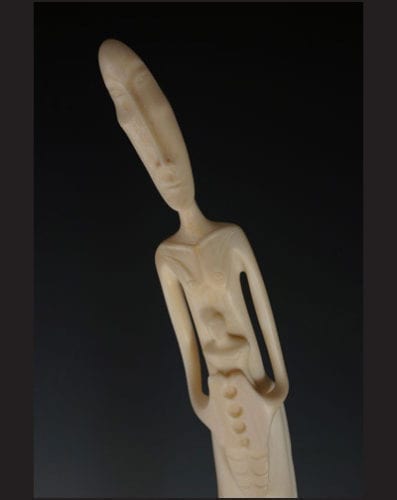Susie Silook, Yup’ik/Inupiaq

Susie Silook is a Siberian Yup’ik/Inupiaq artist from the village of Gambell on St. Lawrence Island, Alaska. She is one of the first female ivory carvers to succeed in a field dominated over many generations by men. Silook’s work is often inspired by ancient ceremonial dolls that have been excavated across Alaska.
The creation of walrus tusk ivory carvings dates back several thousand years; most ancient carvings were created for either utilitarian or ceremonial purposes. Constrained by the circumference of a walrus tusk, these dolls were usually carved with no arms. While the artists may have added arms of wood or skin, these perishable materials have not survived, while ivory has endured. In honor of these ancient carvings, Silook often makes armless figures adorned with curvilinear surface etchings reminiscent of the ancient ones.
Silook has become acquainted with many cultures through her life in Gambell and Anchorage, as well as her service in the military. She brings that broad perspective to life in her art, her poetry and her prose. This external perspective, combined with the inspiration of her native traditions, makes for a very powerful and spritual legacy of art.
Silook’s work is included in many private and corporate collections. Museums holding her work in their permanent collections include: de Young Museum, San Francisco, CA; Anchorage Museum of Art & History, Anchorage, AK; Museum of the North, University of Alaska, Fairbanks; and the Eiteljorg Museum of American Indians and Western Art, Indianapolis, Indiana. Her work was included in Art without Reservation: Changing Hands 2, a touring exhibit sponsored by the Museum of Arts & Design. She was selected as one of 100 artists nationwide to receive a grant from the US Artists foundation in 2008. In 2001, she was awarded a fellowship by the Eiteljorg Museum.
Artist’s statement regarding her father and grandfather:
My grandfather Paul Silook, whose Yupik name Siluk is our surname, was a self described “literary man”.
He served as an assistant to teachers, preachers, and archeologists from the 1920s and beyond. My trip to the Smithsonian in the 1990s introduced me to boxes upon boxes of ethnographic material he’d donated during his work with Henry Collins and others, of our ancient culture rich in ivory artifacts that survive centuries beneath our feet. In his time Alaska was a US territory, only becoming a state one year prior to my birth in 1960.
We didn’t accept the cash settlement of ANCSA, making us the owners of both the surface and subsurface of St. Lawrence Island, one of only two tribes to do so. We’ve successfully inhabited and warded off invaders for at least 2,000 years, with part of our tribe living in Siberia, which is a scant and visible 38 miles away.
Siluk read voraciously, and served as the scribe and translator in our island of Sivuuqaq, which is also the name of our village, Gambell, one of two villages, with our herders establishing a reindeer herding site in Savoonga, and subsequently relocating there with their families. The patriarchal clan system is currently still operational.
He read the I Ching and was able to identify our way of life, our consciousness, as a living expression of that described in that ancient book, infusing his writings with words and concepts from it. In that way he acomplished what no other Indigenous person has, with the prolific amount of material he freely shared, that furthered a deeper understanding of the Yi Jing.
Included were the first census, the formalities of our whale hunt, and stories from our island’s peoples and those of our Siberian kin. Much more was shared with teachers and missionaries, and he was a participant in the early Christian movement, pictured at a stone altar made at our mountain for making sacrifices.
My father’s story telling and historical facts didn’t deviate from his father’s writings, an example of accuracy in our oral tradition. Although I was a girl I listened in and began to carve ivory, and was not discouraged by my family in doing so.
